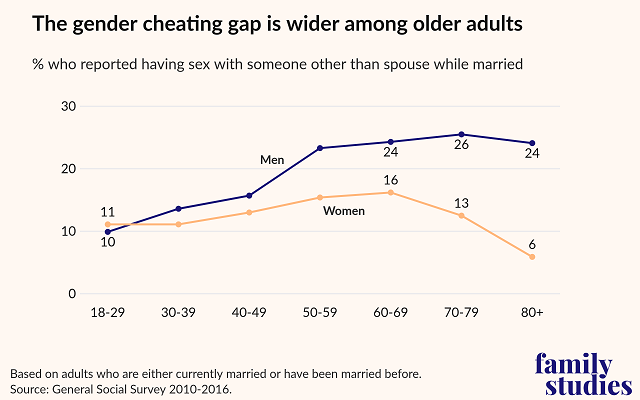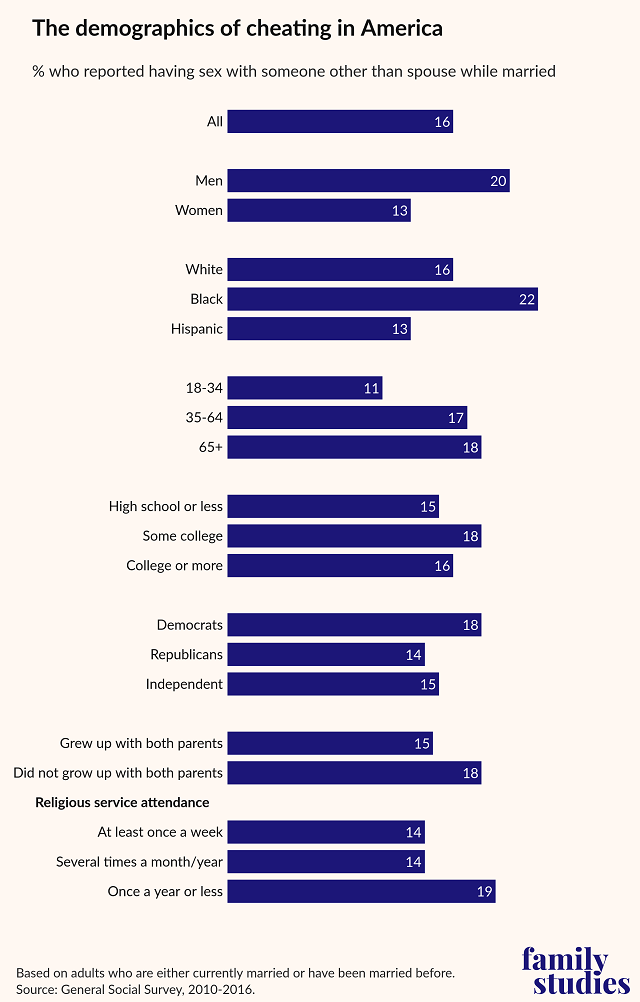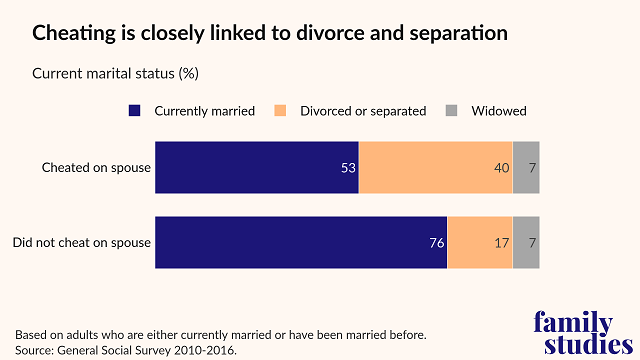Highlights
The last few months of 2017 treated us to a whirlwind of news coverage on sexual harassment and abuse, with powerful men from Hollywood to Washington, D.C. falling because of sexual misconduct. It continues into the new year, with Missouri Governor Eric Greitens the latest to fall. And most of these men are married.
When Time magazine picked the silence breakers as the 2017 “person of the year,” few people paid attention to the other group of women negatively impacted by the fallout—the spouses of the men who engaged in inappropriate or even criminal (in some cases) sexual behavior. To these women, sexual harassment/abuse also means infidelity.
In general, men are more likely than women to cheat: 20% of men and 13% of women reported that they’ve had sex with someone other than their spouse while married, according to data from the recent General Social Survey(GSS).

However, as the figure above indicates, this gender gap varies by age. Among ever-married adults ages 18 to 29, women are slightly more likely than men to be guilty of infidelity (11% vs. 10%). But this gap quickly reverses among those ages 30 to 34 and grows wider in older age groups. Infidelity for both men and women increases during the middle ages. Women in their 60s report the highest rate of infidelity (16%), but the share goes down sharply among women in their 70s and 80s. By comparison, the infidelity rate among men in their 70s is the highest (26%), and it remains high among men ages 80 and older (24%). Thus, the gender gap in cheating peaks among the oldest age group (ages 80+): a difference of 18 percentage points between men and women.
Trend data going back to the 1990s suggests that men have always been more likely than women to cheat. Even so, older men were no more likely to cheat than their younger peers in the past. In the 1990s, the infidelity rate peaked among men ages 50 to 59 (31%) and women ages 40 to 49 (18%). It was lower for both men and women at the older end of the age spectrum. Between 2000 and 2009, the highest rate of infidelity shifted to men ages 60 to 69 (29%) and women ages 50 to 59 (17%). Meanwhile, the gender gap at ages 80+ increased from 5% to 12% in two decades.
A generation or cohort effect is likely to contribute to this shifting gender gap in infidelity. As Nicholas Wolfinger noted in an earlier post, Americans born in the 1940s and 1950s reported the highest rates of extramarital sex, perhaps because they were the first generations to come of age during the sexual revolution. My analysis by gender suggests that men and women follow a slightly different age pattern when it comes to extramarital sex. Women born in the 1940s and 1950s are more likely than other women to be unfaithful to their spouse, and men born in the 1930s and 1940s have a higher rate than other age groups of men. The higher infidelity rates among these two cohorts contribute to the changing pattern in the gender gap as they grow older over time.
In addition to gender and age, the infidelity rate also differs by a number of other demographic and social factors. For example, cheating is somewhat more common among black adults. Some 22% of ever-married blacks said that they cheated on their spouse, compared with 16% of whites and 13% of Hispanics. And among black men, the rate is highest: 28% reported that they had sex with someone other than their spouse, compared with 20% of white men and 16% of Hispanic men.

A person’s political identity, family background, and religious activity are also related to whether or not they cheat. Overall, Democrats, adults who didn’t grow up in intact families, and those who rarely or never attend religious services are more likely than others to have cheated on their spouse. For example, 15% of adults who grew up with both biological parents have cheated on their spouse before, compared with 18% of those who didn’t grow up in intact families.
On the other hand, having a college degree is not linked to a higher chance of cheating. Almost equal shares of college-educated adults and those with high school or less education have been unfaithful to their spouse (16% vs. 15%), and the share among adults with some college education is slightly higher (18%).
Given that many of these factors could be interrelated, I ran a regression model to test the independent effect of each factor. Basically, holding all other factors equal, will each factor still be related to the odds of cheating? It turned out that most of these differences (such as age, race, party identity, religious service attendance, family background) are significant, even after controlling for other factors. And a person’s education level is not significantly associated with cheating.
However, when it comes to who is more likely to cheat, men and women share very few traits. Separate regression models by gender suggest that for men, being Republican and growing up in an intact family are not linked to a lower chance of cheating, after controlling for other factors. But race, age, and religious service attendance are still significant factors. Likewise, men’s education level is also positively linked to their odds of cheating. By comparison, party ID, family background, and religious service attendance are still significant factors for cheating among women, while race, age, and educational attainment are not relevant factors. In fact, religious service attendance is the only factor that shows consistent significance in predicting both men and women’s odds of infidelity.
Infidelity is painful to the person who is being cheated on and can be detrimental to the relationship. Although statistics on the link between infidelity and divorce are hard to find, my analysis based on GSS data suggests that adults who cheated are much more likely than those who didn’t to be divorced or separated.

Among ever-married adults who have cheated on their spouses before, 40% are currently divorced or separated. By comparison, only 17% of adults who were faithful to their spouse are no longer married. On the flip side, only about half of “cheaters” are currently married, compared with 76% of those who did not cheat.
Men who cheated are more likely than their female peers to be married. Among men who have cheated on their spouse before, 61% are currently married, while 34% are divorced or separated. However, only 44% of women who have cheated before are currently married, while 47% are divorced or separated.
This gender difference could reflect the fact that men are more likely to be remarried than women after a divorce. A portion of currently married “cheaters” may be remarried, since we can't tell from the data whether or not the person who cheated is still married to the spouse he or she cheated on.
Wendy Wang is director of research at the Institute for Family Studies and a former senior researcher at Pew Research Center, where she conducted research on marriage, gender, work, and family life in the United States.










